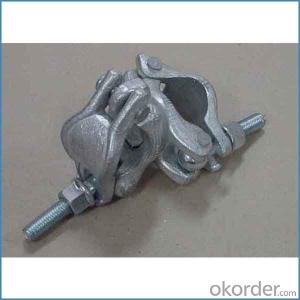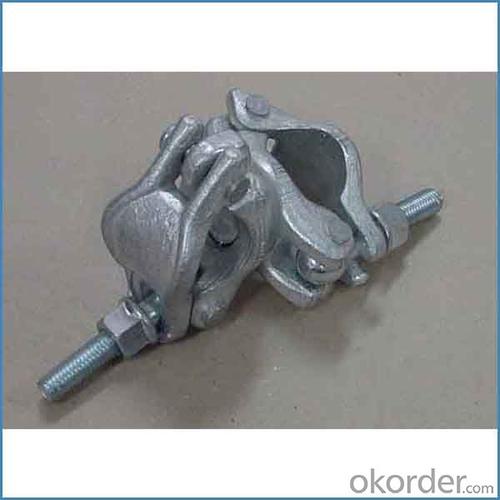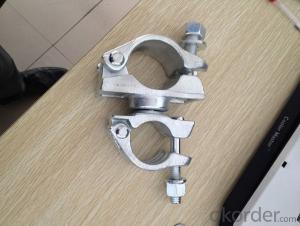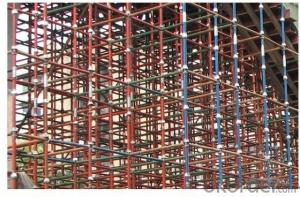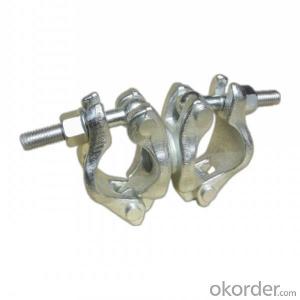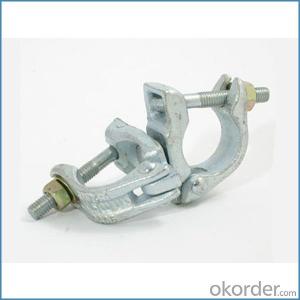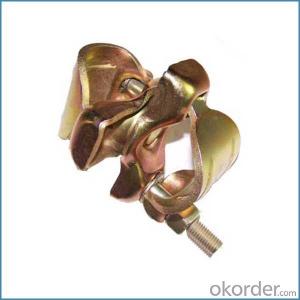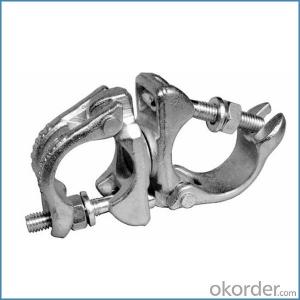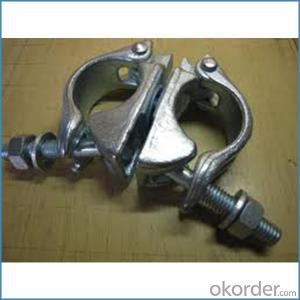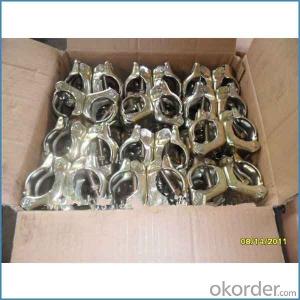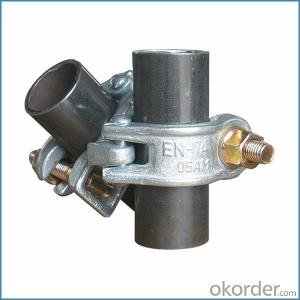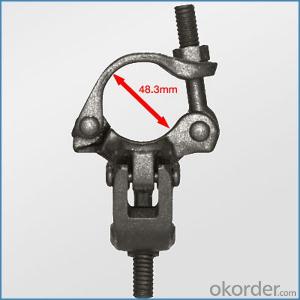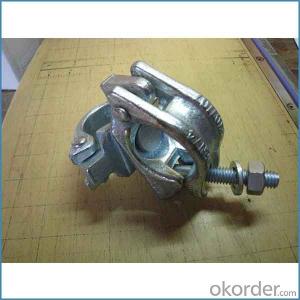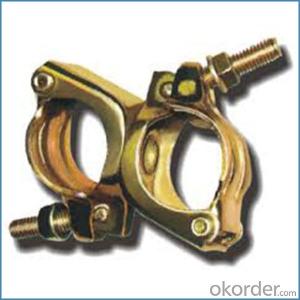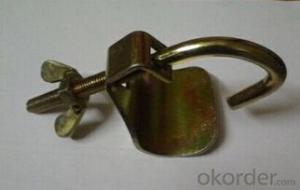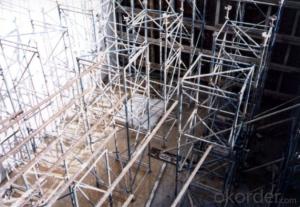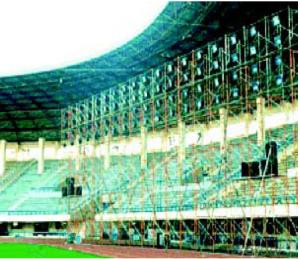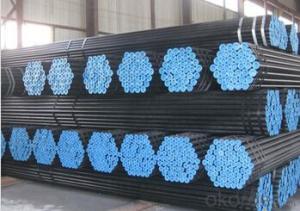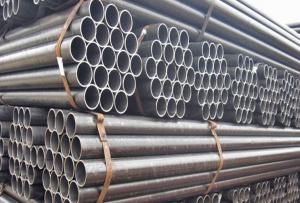32mm Steel Coupler British Type for Sale
- Loading Port:
- Tianjin
- Payment Terms:
- TT OR LC
- Min Order Qty:
- 1000 kg
- Supply Capability:
- 100000 kg/month
OKorder Service Pledge
OKorder Financial Service
You Might Also Like
32mm Steel Coupler British Type for Sale
Description
1.The scaffolding coupler is always used to connect the steel pipe as scaffolding system.
2.The often used coupler is swivel coupler and righ angle coupler .
3.We can provide types of scaffolding coupler according to your requirement.
4.Couoler can fix the 48.3mm scaffolding steel pipe tightly and make the whole scaffolding system more steadily.
5.Material:Q235 steel
6.Overall Size:48.3mm*48.3mm
7.Surface Finish: Galvanized/ Painted
8.Standard:BS1139,EN74
9.Package:25pcs/bag
10.Manufactuering as per customer requirements
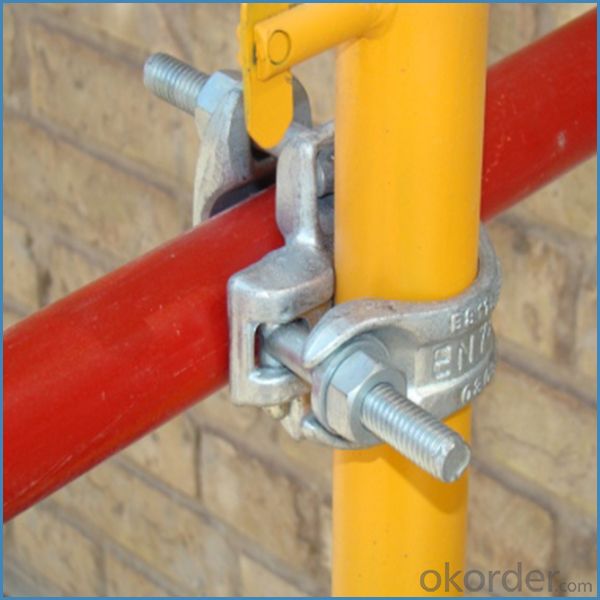
Feature
(1)Excellent Anti-Breaking—Cold Pressed Steel
(2)Outstanding Resistance Deformation
(3)Strong Anti-Dropping Ability
(4)Longtime USe
(5)Qualtity Guaranteed
(6)OEM Service
Photo
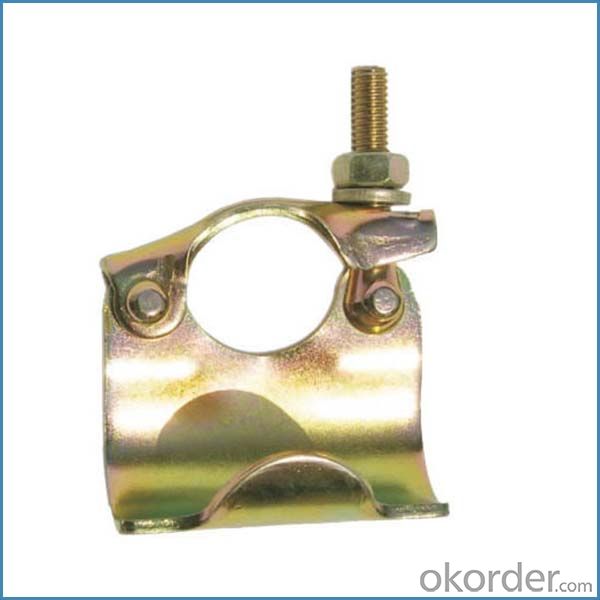
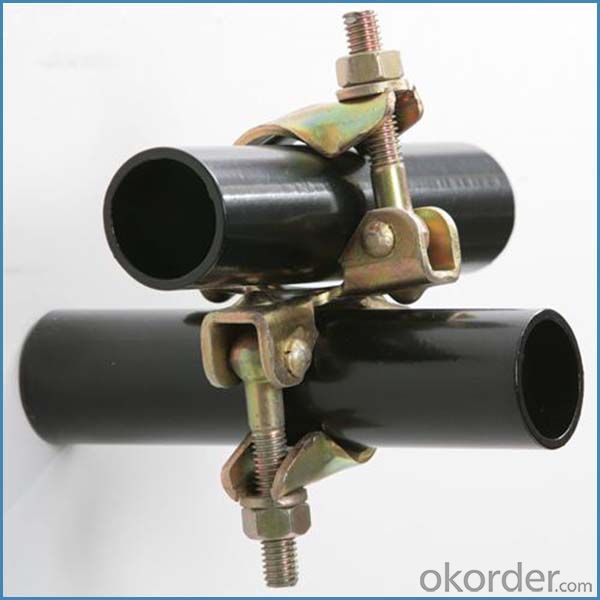
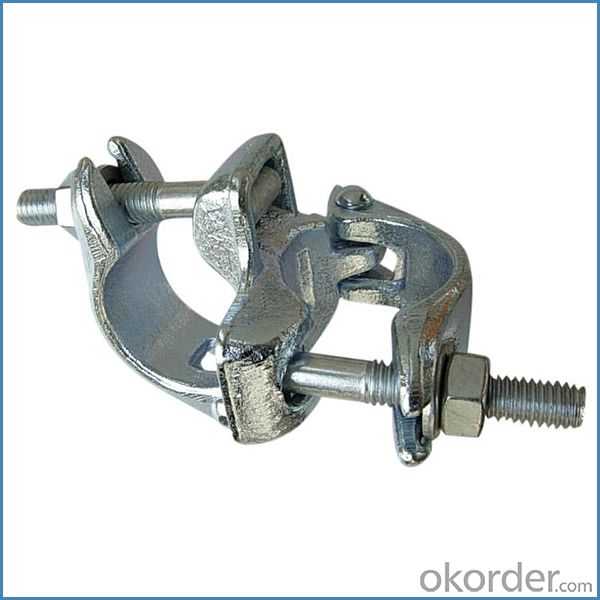
Parameter
| Material | Q235,345steel |
| Size | 48.3mm*48.3mm |
| Surface finish | Galvanized |
| Weight | 1.1kg around |
| Standard | BS1139,EN74 |
| Package | 25pcs/bag,steel pallet |
| Manufacture | As per customer requirement |
| Market | Africa, South America, the Middle East and Asia |
FAQ
Q: Are you a factory or trading company?
We are a state-owned corporation in China,dealing with various kinds of building materials.We have our holding subsidiaries.
Q: Where is your factory located? How can I visit there?
Our factory is located all around China.
Q: Can I get some samples?
Sample is free, customer only pay freight for the first time.
Q: Delivery?
10-30days. (5-15 containers)
Any question,feel free to contact us.
- Q: Are steel tube couplers suitable for use in seismic or earthquake-prone areas?
- Yes, steel tube couplers are suitable for use in seismic or earthquake-prone areas. They are designed to provide strength, stability, and flexibility to withstand the forces and movements generated during an earthquake. Steel tube couplers offer reliable connections between structural elements, ensuring structural integrity and enhancing the overall seismic performance of a building or infrastructure.
- Q: heyi got my scaffold (industrial) piercing done a while ago and it has had enough time to heal but unfortunatley i cant unscrew the balls on the bar help????what can i do?
- I had the same problem. Try putting on some latex gloves to get a better grip and try again. I had to go back to my piercer because I couldn't unscrew them myself.
- Q: Are steel tube couplers suitable for scaffolding projects with specific weight restrictions?
- Steel tube couplers are generally suitable for scaffolding projects with specific weight restrictions. Steel tube couplers are designed to securely connect steel tubes used in scaffolding systems, providing stability and structural support. They are typically manufactured to meet certain load capacities and safety standards, ensuring they can withstand the weight requirements of scaffolding projects. However, it is important to consider the specific weight restrictions and requirements of your scaffolding project before using steel tube couplers. Different couplers may have varying load capacities, so it is crucial to select the appropriate type and size of coupler based on the expected loads and weight restrictions of your scaffolding system. Additionally, it is advisable to consult with a structural engineer or scaffolding expert to ensure that the steel tube couplers you plan to use are suitable for your specific weight restrictions. They can provide guidance on the appropriate coupler types, sizes, and configurations that will meet the necessary safety standards and load capacities for your scaffolding project. In summary, steel tube couplers can be suitable for scaffolding projects with specific weight restrictions, but it is essential to carefully consider the load capacities, safety standards, and consult with experts to ensure the proper selection and use of couplers in order to meet the weight requirements of your project.
- Q: Are steel tube couplers suitable for scaffolding projects requiring frequent disassembly and reassembly?
- Yes, steel tube couplers are suitable for scaffolding projects requiring frequent disassembly and reassembly. Steel tube couplers provide a strong and secure connection between scaffolding tubes, making it easier to dismantle and reassemble the scaffolding system multiple times without compromising its stability or integrity.
- Q: Are steel tube couplers adjustable for different widths in scaffolding with limited access?
- No, steel tube couplers are not adjustable for different widths in scaffolding with limited access. Steel tube couplers are designed to connect two tubes of the same diameter and maintain a fixed connection between them. They provide a secure and rigid joint, ensuring the stability and safety of the scaffolding structure. However, if different widths or sizes of tubes need to be connected in scaffolding with limited access, alternative solutions such as adjustable scaffolding clamps or specialized connectors may be necessary. These solutions can provide the flexibility needed to accommodate different widths while still maintaining the required strength and stability in the scaffolding system.
- Q: Can steel tube couplers be used in scaffolding projects with limited overhead clearance due to existing structures?
- Scaffolding projects with limited overhead clearance due to existing structures can utilize steel tube couplers. These couplers are specifically designed to connect steel tubes, enabling the creation of scaffolding structures. Their versatility allows for various configurations, making it possible to construct scaffolding systems that can fit into tight spaces. When faced with limited overhead clearance, steel tube couplers are the ideal solution to construct a scaffolding system that fits within the available space while providing the required support and stability. To ensure safety and compliance with local regulations, it is crucial to have a qualified professional properly design and install the scaffolding system.
- Q: Are steel tube couplers suitable for scaffolding projects with specific height restrictions?
- Indeed, scaffolding projects with specific height restrictions can benefit greatly from the use of steel tube couplers. These couplers are extensively employed in the construction and scaffold industries due to their impressive strength, durability, and ability to establish secure connections between scaffolding tubes. They are explicitly engineered to endure heavy loads and guarantee the stability and safety of the scaffold structure. When tackling projects with height restrictions, steel tube couplers offer numerous advantages. To begin with, they are available in a variety of sizes and configurations, enabling flexibility in meeting specific height requirements. Couplers can be utilized to vertically or horizontally connect multiple tubes, ensuring that the scaffold can be constructed to the desired height while simultaneously maintaining stability and safety. Moreover, steel tube couplers are known for their ease and speed of assembly and disassembly, a feature that proves particularly advantageous in projects with height restrictions. This facilitates efficient installation and removal of the scaffolding as needed, minimizing any disruptions to the construction process. Furthermore, steel tube couplers provide a reliable and secure connection between scaffold tubes. This aspect is of utmost importance in projects with height restrictions, as the scaffold structure must remain stable and capable of withstanding external forces such as wind or heavy loads. The robust nature of steel tube couplers assures that the scaffold remains secure and safe, even at greater heights. In conclusion, steel tube couplers are highly suitable for scaffolding projects with specific height restrictions. Their strength, versatility, and ability to establish secure connections make them the ideal choice for constructing scaffolding that complies with height limitations while simultaneously ensuring stability and safety.
- Q: How do steel tube couplers prevent tubes from slipping or rotating?
- By utilizing a combination of mechanical design and friction, steel tube couplers effectively prevent the slipping or rotating of tubes. These couplers have been specifically engineered to establish a secure connection between two steel tubes, guaranteeing their stability under various loads and conditions. The internal gripping mechanism of the coupler is one of its key features in preventing slipping or rotating. This mechanism typically comprises a series of teeth or ridges that are strategically designed to penetrate the surface of the tubes once they are inserted into the coupler. This action creates a robust grip between the coupler and the tubes, effectively preventing any movement or rotation. In addition, the coupler is often fashioned with a snug fit between its inner diameter and the outer diameter of the tubes. This ensures that there is minimal space between the two surfaces, significantly reducing the likelihood of any movement or rotation. Moreover, the coupler is usually crafted from a material with a high coefficient of friction, such as steel. This characteristic means that when the tubes are inserted into the coupler, the friction between the surfaces intensifies, providing enhanced resistance against slipping or rotating. In summary, steel tube couplers are meticulously designed to establish a secure and dependable connection between steel tubes. Through their internal gripping mechanism, snug fit, and high coefficient of friction, they effectively prevent the slipping or rotating of tubes, thus ensuring the stability and integrity of the overall structure.
- Q: What are the advantages of using steel tube couplers in scaffolding?
- Using steel tube couplers in scaffolding offers numerous benefits: 1. Exceptional strength and durability: Steel tube couplers are crafted from high-grade steel, providing unparalleled strength and durability. They can withstand heavy loads and adverse weather conditions, making them ideal for robust construction projects. 2. Flexibility: Steel tube couplers can be utilized with a wide array of scaffold tubes, allowing for adaptable configurations and effortless assembly. This versatility makes them suitable for various construction applications, including building maintenance, renovations, and infrastructure projects. 3. Enhanced safety: Steel tube couplers establish secure and reliable connections between scaffold tubes, ensuring the stability and safety of the scaffolding structure. Their design prevents slippage or disconnection, reducing the risk of accidents and injuries. 4. Cost-effectiveness: Steel tube couplers present a cost-effective solution for scaffolding needs. They are relatively inexpensive compared to other scaffolding systems, and their durability ensures a longer lifespan, reducing the frequency of replacements or repairs. 5. Simple installation and dismantling: Installing and dismantling steel tube couplers is effortless, saving time and effort during construction projects. No specialized tools or skills are required, making them accessible to a wide range of workers. 6. Compatibility: Steel tube couplers are compatible with various scaffolding accessories, including platforms, boards, and guardrails. This compatibility allows for customized and adaptable scaffolding systems to meet specific project requirements. 7. Reduced weight: Compared to traditional scaffolding systems, steel tube couplers are lightweight, making them easier to transport and handle. This advantage proves particularly beneficial for projects that demand frequent mobility or involve confined spaces. In conclusion, the use of steel tube couplers in scaffolding provides numerous advantages, including strength, durability, flexibility, safety, cost-effectiveness, easy installation, compatibility with accessories, and reduced weight. These benefits establish steel tube couplers as an excellent choice for construction projects that require reliable and efficient scaffolding solutions.
- Q: Can steel tube couplers be used in conjunction with other scaffolding connectors?
- Yes, steel tube couplers can be used in conjunction with other scaffolding connectors. Steel tube couplers are commonly used in scaffolding systems to connect and secure the steel tubes together. They provide a strong and reliable connection between the tubes, ensuring the stability and integrity of the scaffolding structure. In addition to steel tube couplers, there are other types of scaffolding connectors such as swivel couplers, putlog couplers, and sleeve couplers, among others. These connectors serve different purposes and can be used in combination with steel tube couplers to meet specific scaffolding requirements. The choice of connectors depends on factors such as the type of scaffolding system being used, the load-bearing capacity needed, and the specific configuration of the scaffold.
Send your message to us
32mm Steel Coupler British Type for Sale
- Loading Port:
- Tianjin
- Payment Terms:
- TT OR LC
- Min Order Qty:
- 1000 kg
- Supply Capability:
- 100000 kg/month
OKorder Service Pledge
OKorder Financial Service
Similar products
Hot products
Hot Searches
Related keywords
